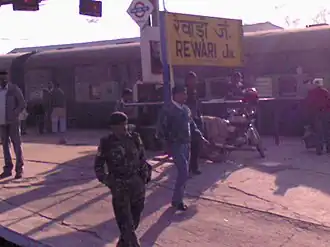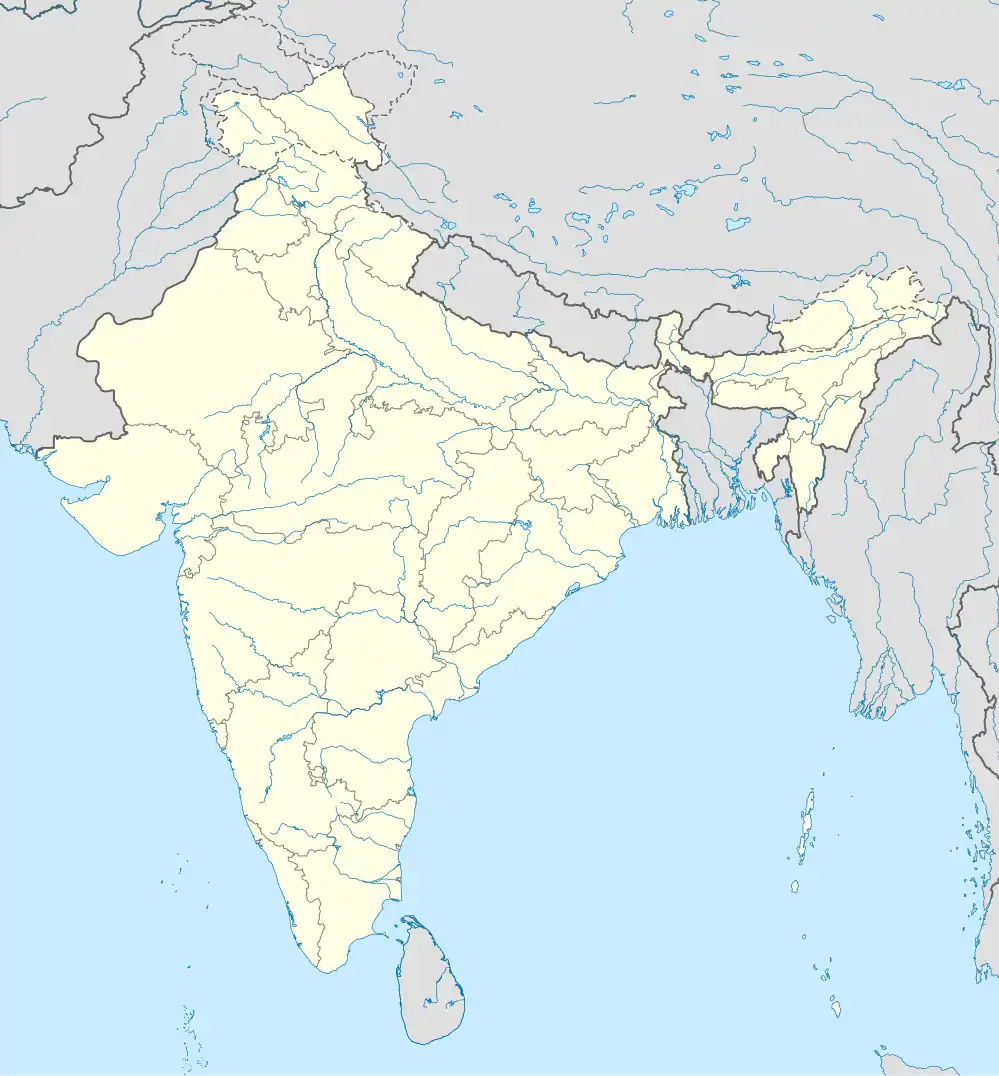Rewari Junction railway station
Rewari Junction | |||||
|---|---|---|---|---|---|
The station in 2008 | |||||
| General information | |||||
| Location | Station Road, Rewari, Haryana India | ||||
| Coordinates | 28°12′12″N 76°36′40″E / 28.20333°N 76.61111°E | ||||
| Elevation | 246 metres (807 ft) | ||||
| Owned by | Indian Railways | ||||
| Operated by | Indian Railways | ||||
| Line(s) | Delhi–Ajmer line Bathinda–Rewari line Rewari–Rohtak line Bikaner–Rewari line Ringus–Rewari line | ||||
| Platforms | 8 | ||||
| Tracks | 14 | ||||
| Bus routes | 6 | ||||
| Construction | |||||
| Structure type | Intermediate Junction | ||||
| Parking | Available(paid) | ||||
| Other information | |||||
| Status | Functional | ||||
| Station code | RE[1] | ||||
| Zone(s) | North Western Railway zone | ||||
| Division(s) | Jaipur | ||||
| History | |||||
| Opened | 1873 | ||||
| Rebuilt | 2009–11 | ||||
| Electrified | Yes | ||||
| Passengers | |||||
| 35000 per day | |||||
| |||||

Rewari Junction railway station (station code: RE[1]) is a major railway station of the Indian Railways serving the city of Rewari in the Indian state of Haryana. It is in the Jaipur Division of the North Western Railway zone and 7 railway lines branch out from this railway station. It will be integrated with the Rewari RRTS station of Delhi–Alwar RRTS.[2][3]
Rewari Railway Heritage Museum, built in 1893 is the only surviving steam loco shed in India and houses some of India's last surviving steam locomotives including world's oldest working engine and one of national treasure (cultural artifacts) of India Fairy Queen,[4][5][6][7][8] is known for heritage tourism and for shooting of several movies.[4][9]
History
In 1873, Rewari railway station was built on 82.3 kilometres (51.1 mi) long first commercial 1,000 mm (3 ft 3+3⁄8 in) metre-gauge track in India from Delhi to Rewari by Rajputana State Railway.[10][11] A 41.4 kilometres (25.7 mi) long segment of the railway line had been laid a year earlier from Delhi to Garhi Harsaru that catered to existing flourishing salt production works (from underground brine) at Farrukhnagar, 13.8 kilometres (8.6 mi) to its west.
In 1874, 1875 and 1881, the railway line was extended 135.8 kilometres (84.4 mi) from Rewari to Alwar-Bandikui, further 225.2 kilometres (139.9 mi) to Jaipur-Ajmer, and eventually another 492 kilometres (306 mi) to Ahmedabad in Gujarat respectively by Rajputana–Malwa Railway.
In 1884, Rewari became a railway junction when, a 300.65 kilometres (186.82 mi)-long metre-gauge railway line to Bhatinda was completed by Rajputana–Malwa Railway[12]
In 1986, 379 kilometres (235 mi) long line to Bikaner via Kanina, Loharu, Sadulpur, Churu & Ratangarh was laid.[13]).
In 1905, 216 kilometres (134 mi) long line to Phulera via Narnaul, Neem-Ka-Thana and Ringas was laid. Eventually five metre-gauge tracks branched out from Rewari. All metre-gauge trains starting from (and terminating at) Delhi railway junction (station code DLI) to Punjab, Rajputana, Saurashtra, Kutch and north Gujarat regions passed through Rewari station. The management of Rajputana–Malwa Railways (and Rewari railway station) was transferred to Bombay, Baroda and Central India Railway (BBCI) in 1889. BBCI became Western Railway in 1951.
In 1952, Delhi–Rewari–Bikaner railway line were transferred to Bikaner Division of newly formed Northern Railway zone in 1952 while Rewari–Jaipur and Rewari–Ringas–Phulera sections remained in Western Railway.
In 1992, Delhi–Rewari railway line had double 1,000 mm (3 ft 3+3⁄8 in) metre gauge and one of the tracks was converted to 5 ft 6 in (1,676 mm) broad gauge as a part of conversion of Ajmer–Delhi line.[14]
In 1993, Rewari–Bhatinda track was converted to broad gauge.[5]
In 1994, Rewari–Jaipur–Ajmer track was converted to broad gauge. In May 1997, broad-gauge trains started running from Ahmedabad to Delhi via Rewari. Within a few years, both the tracks from Sarai Rohilla to Delhi railway junction were converted to broad gauge and all metre-gauge trains stopped operating from Delhi Junction. As a result of this, all metre-gauge trains to Rewari and beyond terminated at and started from Sarai Rohilla which became a railway terminus.[15]
By September 2004, the second metre-gauge track from Sarai Rohilla to Rewari was also converted to broad gauge and all metre-gauge trains stopped operating between Rewari and Sarai Rohilla (though the converted track was "officially" dedicated to the nation by politicians only in October 2006).[15][16]
By 2009, all metre-gauge railway tracks from Rewari were converted to broad gauge.[17]
Until 2010, Rewari was the world's oldest and largest commercial metre-gauge railway junction.[17]
In 2008, 361 kilometres (224 mi) long Rewari–Ajmer railway line via Bandikui and Jaipur was double tracked. In 2021, Rewari-Ajmer-Palanpur-Ahmedabad, Rewari-Hisar, and Rewari-Ludhiana lines were doubled.
In 2017, Alwar-Rewari–Hisar and Rewari–Narnaul–Ringas–Phulera railway tracks were electrified.[18]
In 2020, Rewari–Ajmer railway track was electrified.[18][19] Later, Rewari–Ringas–Ajmer–Palanpur 654 kilometres (406 mi) long track and Rewari–Ringas–Ajmer–Palanpur–Mehsana railway track were also electrified.[18]
In 2004–06, facilities were upgraded via Rewari for running double-stack goods trains from Rewari to Bombay, Kandla and other ports in western India from Delhi and northern states/union territories of Haryana, Punjab, Himachal Pradesh and Jammu and Kashmir.[20] Some private logistics operators have built container storage yards north of Rewari near Garhi Harsaru (south of Gurgaon) for this purpose.
In 2025-26, Rewari station underwent ₹12 crore upgrade with improved station building facade, new lifts and escalators, renovated waiting rooms and toilets, new coach guidance system, separate arrival and departure gates, enhanced parking, and an attractive boundary wall.[21]
Facilities
Rewari railway station has all major facilities like high-level platforms, waiting rooms, restaurants, computerised ticket reservation, bookshop and retiring rooms for sleeping. On conversion of metre-gauge tracks to broad gauge, the station yard was remodelled and the tracks and platforms were rearranged to provide 8 platforms in 2009–10; low-level metre-gauge platforms were raised higher. Some heritage buildings that were more than 100 years old were demolished to lay new railway lines and build high-level platforms.[22] New buildings have been constructed.
Train services
Rewari railway junction station is located 82.3 kilometres (51.1 mi) southwest of old Delhi and 75.6 kilometres (47.0 mi) southwest of the nearest large airport is located at New Delhi.
Rail lines
1,676 mm (5 ft 6 in) broad-gauge tracks branch out from Rewari towards
- Delhi 82.3 kilometres (51.1 mi) .
- Ajmer via Alwar, Bandikui and Jaipur 361 kilometres (224 mi)
- Phulera via Narnaul, Neem-Ka-Thana and Ringas 216 kilometres (134 mi)
- Bikaner via Loharu, Sadulpur, Churu & Ratangarh 379 kilometres (235 mi)
- Bhatinda via Charkhi Dadri, Bhiwani and Hisar 300.65 kilometres (186.82 mi)
- Rohtak via Jhajjar 72.9 kilometres (45.3 mi)(constructed in 2008–2012 and commissioned in January 2013)
- Rewari-Asaoti as a part of the Western Dedicated Freight Corridor[23][24][25][26]
Trains
The following is a list of a few trains stopping at Rewari railway station.
| Train no. | Train name | Zone | From | To | Scheduled dep |
|---|---|---|---|---|---|
| 12915 | Ashram Express | WR | Ahmedabad/ADI | Delhi/DLI | 08:35 |
| 12372 | Jaisalmer–Howrah Express | ER | Jaisalmer/JSM | Howrah/HWH | 11:50 |
| 22452 | Mumbai–Bandra–Chandigarh Exp | NR | Bandra/BDTS | Chandigarh/CDG | 10:30 |
| 19602 | New Jalpaiguri–Ajmer Exp | NWR | New Jalpaiguri/NJP | Ajmer/AII | 15:10 |
| 19565 | Uttaranchal Exp | WR | Okha/OKHA | Dehradun/DDN | 07:45 |
| 12413 | Pooja Exp | NR | Ajmer/AII | Jammu/JAT | 20:18 |
See also
References
- ^ a b "Station Code Index" (PDF). Portal of Indian Railways. Centre For Railway Information Systems. 2023–24. p. 7. Archived from the original (PDF) on 16 February 2024. Retrieved 23 March 2024.
- ^ "Gurgaon–Rewari MRTS mooted". The Times of India. 21 November 2009. Archived from the original on 26 January 2013.
- ^ "अरावली में अंडरग्राउंड गुजरेगी रैपिड रेल".
- ^ a b Ghosh, Dwaipayan (10 August 2010). "Eye on Games, black beauties gather steam". The Times of India. Archived from the original on 6 November 2012.
- ^ a b Overview of Bikaner Division
- ^ "National Conference on Steam Heritage Tourism inaugurated". Ministry of Railways. 2 December 2002.
- ^ "Gathering steam". The Indian Express. 4 April 2010. Retrieved 5 October 2010.
- ^ "Rewaristeamloco.com". Retrieved 4 October 2014.
- ^ "Charm of Chhuk-Chhuk". The Tribune. India. 3 July 2005.
- ^ "MG". Nwr.indianrailways.gov.in. 3 May 1997. Retrieved 6 October 2013.
- ^ "Chronology of railways in India, Part 2 (1870–1899)". IRFCA.org. Retrieved 24 October 2014.
- ^ "Gazetteer of India, Haryana, Hisar" (PDF). Communications, page 135. Haryana Government. Archived from the original (PDF) on 1 May 2014. Retrieved 10 May 2014.
- ^ "Rajputana Malwa State Railway". fibis. Retrieved 10 May 2014.
- ^ "IRFCA] Indian Railways FAQ: IR History: Part 5 Ajmer–Delhi MG railway line converted to BG". Retrieved 4 October 2014.
- ^ a b "Press Information Bureau English Releases". Retrieved 4 October 2014.
- ^ "Delhi–Haryana rail link gets better". The Hindu. 8 October 2007. Archived from the original on 13 October 2007.
- ^ a b "World's oldest commercial meter gauge is history". The Times of India. 31 July 2010. Archived from the original on 15 November 2013. Retrieved 24 October 2014.
- ^ a b c "Blue print for Railway Electrification" (PDF). Archived from the original (PDF) on 18 April 2011.
- ^ Blue print for Railway Electrification (PDF). Government of India – Ministry of Railways Railway Board. 4 April 2011. Retrieved 24 October 2014.
- ^ Double stack containers 2896mm high permitted to run on Gurgaon–Rewari section at max. 75 kmph speed
- ^ Jha, B. (2023, July 28). "Revamp Of Ggn, Rewari & Pataudi Railway Stations Likely To Start Soon." The Times of India.
- ^ "Haryana Plus". Tribune India. 31 December 2009. Retrieved 6 October 2013.
- ^ Town and Country Planning Department Notification (PDF). Haryana: Haryana Government. 28 December 2007. Retrieved 24 October 2014.
- ^ "Status of Dedicated Freight Corridors of Indian Railways – 238". Steelguru.com. 30 November 2011. Retrieved 6 October 2013.
- ^ "Dedicated Freight Corridor Project". Railway Technology. 15 June 2011. Retrieved 6 October 2013.
- ^ A 32km single line from proposed Pirthala railway junction (near Asaoti station on Delhi–Mathura line) to Tughlakabad

